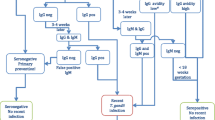Abstract
Background
The overall seroprevalence of toxoplasma antibodies in women of childbearing age in Ireland is 25% [1]. Hence, 75% of women remain susceptible to primary toxoplasma infection during pregnancy, which if transmitted to the foetus can cause ocular, neurological and other sequelae. Toxoplasma exposure during pregnancy can be avoided if there is an awareness of the potential sources of infection, mainly contaminated food, water, soil and cat faeces.
Aims
To determine risk factor exposure in a cohort of women with congenitally infected infants and to assess maternal risk awareness prior to diagnosis of infection.
Methods
Data, prospectively gathered during 2 years of pilot newborn screening for congenital toxoplasmosis in Ireland, was retrospectively analysed. Known risk factors for acquisition of infection were identified. Women were questioned regarding risk awareness and implementation of avoidance measures, if any, during pregnancy.
Results
Fifteen congenitally infected infants were identified by newborn screening. Seventy-three percent of their mothers (11/15) reported lack of knowledge concerning risk factors for toxoplasma infection or its potential threat to the foetus. Ingestion of raw or undercooked meat during pregnancy was the predominant source of toxoplasma cyst exposure identified. Contact with cats was reported in just one case.
Conclusions
Most women were uneducated about the risks posed by Toxoplasma gondii exposure during pregnancy. There is a clear need for better educational programmes regarding primary prevention of congenital toxoplasmosis if neonatal infection is to be avoided.
Similar content being viewed by others
References
Ferguson W, Mayne PD, Lennon B, Butler KM, Cafferkey M (2008) Susceptibility of pregnant women to toxoplasma infection-potential benefits for newborn screening. IMJ 101(7):220–221
Ajzenberg D, Cogne N, Paris L et al (2002) Genotype of 86 Toxoplasma gondii isolates associated with human congenital toxoplasmosis and correlation with clinical findings. J Infect Dis 186(5):684–689
Peyron F, Lobry JR, Musset K et al (2006) Serotyping of Toxoplasma gondii in chronically infected pregnant women: predominance of type II in Europe and types I and III in South America. Microbes Infect 8(9–10):2333–2340
Leal FE, Cavazzana CL, de Andrade HF Jr, Galisteo AJ Jr, de Mendonca JS, Kallas EG (2007) Toxoplasma gondii pneumonia in immunocompetent subjects: case report and review. Clin Infect Dis 44(6):e62–e66
Holland GN (2003) Ocular toxoplasmosis: a global reassessment. Part 1: Epidemiology and course of disease. Am J Ophthalmol 136(6):973–988
Cook AJ, Gilbert RE, Buffolano W et al (2000) Sources of toxoplasma infection in pregnant women: European multicentre case-control study. European Research Network on Congenital Toxoplasmosis. BMJ 321(7254):142–147
Lopez A, Dietz VJ, Wilson M, Navin TR, Jones JL (2000) Preventing congenital toxoplasmosis. MMWR Recomm Rep 49(RR-2):59–68
McLeod R, Boyer K, Karrison T et al (2006) Outcome of treatment for congenital toxoplasmosis, 1981–2004: the National Collaborative Chicago-Based, Congenital Toxoplasmosis Study. Clin Infect Dis 42:1383–1394
Havelaar AH, Kemmeren JM, Kortbeek LM (2007) Disease burden of congenital toxoplasmosis. Clin Infect Dis 44:1467–1474
Wallon M, Kodjikian L, Binquet C et al (2004) Long-term ocular prognosis in 327 children with congenital toxoplasmosis. Paediatrics 113(6):1567–1572
Gilbert RE, Freeman K, Lago EG et al (2008) Ocular sequelae of congenital toxoplasmosis in Brazil compared with Europe. PLoS Negl Trop Dis 2(8):e277
Pinon JM, Dumon H, Chemla C et al (2001) Strategy for diagnosis of congenital toxoplasmosis: evaluation of methods comparing mothers and newborns and standard methods for postnatal detection of immunoglobulin G, M, and A antibodies. J Clin Microbiol 39(6):2267–2271
Di Mario S, Basevi V, Gagliotti C et al (2009) Prenatal education for congenital toxoplasmosis. Cochrane Database Syst Rev (Issue 1):Art. No. CD006171. doi:10.1002/14651858.CD006171.pub2
Breugelmans M, Naessens A, Foulon W (2004) Prevention of toxoplasmosis during pregnancy-an epidemiologic survey over 22 consecutive years. J Perinat Med 32(3):211–214
Montoya JG, Remington JS (2008) Management of Toxoplasma gondii infection during pregnancy. Clin Infect Dis 47(4):554–566
Villena I, Ancelle T, Delmas C et al (2010) Congenital toxoplasmosis in France in 2007: first results from a national surveillance system. Euro Surveill 15(25):pii = 19600. http://www.eurosurveillance.org/ViewArticle.aspx?Articleld=19600. Accessed 10 Feb 2011
Jones JL, Kruszon-Moran D, Wilson M, Mc Quillan G, Navin T, Mc Auley JB (2001) Toxoplasma gondii infection in the United States: seroprevalence and risk factors. Am J Epidemiol 154(4):357–365
Gollub EL, Leroy V, Gilbert R, Chene G, Wallon M (2008) European Toxoprevention Study Group (EUROTOXO). Effectiveness of health education on Toxoplasma related knowledge, behaviour, and risk of seroconversion in pregnancy. Eur J Obstet Gynecol Reprod Biol 136(2):137–145
Jones JL, Krueger A, Schulkin J, Schantz PM (2010) Toxoplasmosis prevention and testing in pregnancy, survey of obstetrician-gynaecologists. Zoonoses Public Health 57(1):27–33
The SYROCOT (Systematic Review on Congenital Toxoplasmosis) study group, Thiebaut R, Leproust S, Chene G, Gilbert RE (2007) Effectiveness of prenatal treatment for congenital toxoplasmosis: a meta-analysis of individual patients’ data. Lancet 369(9556):115–122
Acknowledgments
The authors wish to thank Dr. E. Guy and the staff at The Toxoplasma Reference Laboratory, Singleton Hospital, Swansea, UK for conducting confirmatory serology and facilitating results. We also thank newborn screening liaison midwives nationwide, staff at The National Newborn Screening Laboratory and The National Virus Reference Laboratory Dublin, the infectious diseases team at Our Lady’s Children’s Hospital Dublin, Microbiology service teams for providing stored maternal serology, and Paediatric service teams nationwide for facilitating infant evaluation. We acknowledge the women who consented to participate in this study. The National Pilot Newborn Screening Programme for Congenital Toxoplasmosis was funded by the Department of Health and Children.
Conflict of interest
None.
Author information
Authors and Affiliations
Corresponding author
Rights and permissions
About this article
Cite this article
Ferguson, W., Mayne, P.D., Cafferkey, M. et al. Lack of awareness of risk factors for primary toxoplasmosis in pregnancy. Ir J Med Sci 180, 807–811 (2011). https://doi.org/10.1007/s11845-011-0723-3
Received:
Accepted:
Published:
Issue Date:
DOI: https://doi.org/10.1007/s11845-011-0723-3



